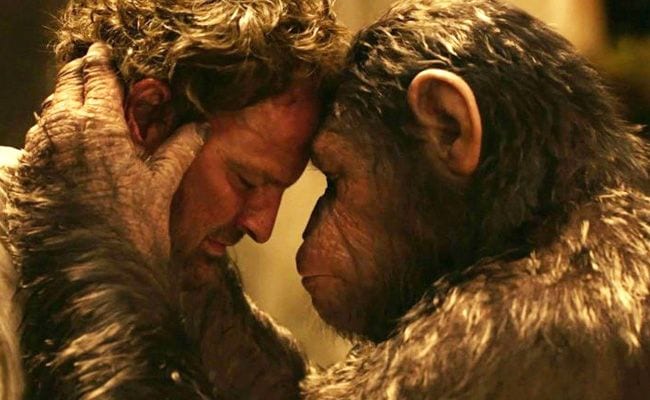
Dawn of the Planet of the Apes marks two blockbuster series that Andy Serkis has enhanced and also encircled with his finicky, emotive genius. By the time The Lord of the Rings cycle wheezed to a close, one could be forgiven for thinking that his Gollum was the only character (besides Ian McKellan’s Gandalf) who provided any dramatic grit. Whether wheedling the hobbitses for favors or struggling with his own divided nature, Gollum was the epicenter of all scenes where he appeared.
As Caesar, Serkis embodies a moral and emotional authority that’s difficult to quantify. It’s a domineering but delicate performance that, through no fault of the performer, ends up handcuffing the film. Much like Rise of the Planet of the Apes, the sequel can’t tear its gaze away from Caesar’s face and form, and in particular the conflict he portrays, between his history with humans (that is, James Franco) and his presumed future with apes. This focus too often distracts from the clash between species that drives the film’s plot.
When Dawn of the Planet of the Apes begins, Caesar’s apes are living in the redwoods north of San Francisco. Ten years of the pandemic unleashed at the end of Rise of the Planet of the Apes have decimated humanity, leaving the apes to build their own rudimentary but stable hunter-gatherer society. A twist on the original Planet of the Apes‘ opening human-chase scene shows the apes hunting deer in large, organized groups, using spears and horses. A surprise encounter between two apes and a trigger-happy human initiates the trouble to follow.
The first half of Dawn of the Planet of the Apes traces the delicate web of diplomacy and suspicion as the two groups circle each other. Caesar, who wisely wants to avoid war, allows the humans into the apes’ territory so that they can start up the power plant at a dam to bring electricity back to their colony of survivors. The humans, led by Dreyfus (Gary Oldman), doubt and revile the apes because they’re “animals.” Both sides are depicted as panicky mobs, easily pushed to violence and only barely restrained by Caesar and his human counterpart Malcolm (a colorless Jason Clarke).
The groups’ mutual mistrust is fueled by dark memories: most humans blame the pandemic on apes, calling it the “Simian Flu,” while the older apes remember all too well being caged and used for experiments. In one sharp scene, Caesar’s rebellious lieutenant Koba (Toby Kebbell), hearing about the “human work” on the dam, points to each of his scars while flatly intoning, “Human work.” Opposed to this remarkable moment but no less moving, the movie includes scenes of inter-species tenderness, such as Malcolm’s son (Kodi Smit-McPhee) cementing his friendship with the peaceful orangutan Maurice (Karin Konoval) by reading a Daniel Clowes graphic novel together.
As effective as such moments may be, however, the movie is also expected to deliver summer action set-pieces, including the battle featuring a rifle-wielding ape cavalry that was promised in its saturation ad campaign. As misunderstandings accumulate and warmongers on both sides get their way, battle is joined on the crumbled, vine-covered streets of San Francisco. Many, many apes are shot down but curiously, we see just about no humans killed. This may be a nod to a speciesist ratings board in order to keep a PG-13, but it also points to a general lack of interest in the human characters. Even the heroic humans are pallid and unmemorable, unlike the carefully delineated apes. By the time the apes do gear up for battle, the audience is ready to charge right along with them.
Such empathy repeats the thematic focus of the original film series. In Rod Serling’s 1968 script, the ape-ruled future was just desserts for humans blowing their civilization to hell with nukes. The following films were mostly revisionist backstory, showing in highly satirical fashion how mankind enslaved intelligent apes, who then revolted. The new series isn’t working toward a predetermined endpoint. (And this may not be a bad thing, as few people will argue for the greatness of, say, 1972’s Conquest of the Planet of the Apes, starring Ricardo Montalban.) Instead, Dawn of the Planet of the Apes appears to be picking through through the old series’ iconography while failing to seed much curiosity about how the inevitable sequel will pick things up.
Still, director Matt Reeves handles this open-endedness with a fine touch, uncommon among big-budget filmmakers. But even as he delivers large and chaotic scenes without chopping them into nonsense, the film is caught up by the demands of the blockbuster in its draggy final third. Yes, there is a climactic scene involving a fight on a very tall structure and yes, every dramatic beat is overplayed and repeated. Reeves seems especially fond of ponderous close shots where hands are poignantly extended or characters gaze at each other in a silent exchange, as if asking, “Why can’t we all just get along?”
Many of these images, of course, concern Caesar. Because Serkis is able to wring so much pathos out of a furrowed brow or damp eye, Dawn of the Planet of the Apes seems reluctant to grant anybody else much room. Too often, this leaves the film looking as divided and constrained as its hero.

